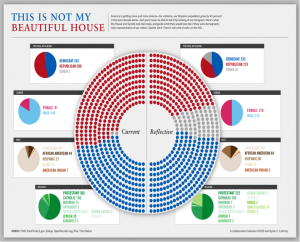Written by AshLee Smith
When the 114th congress began, many headlines noted that this congress was the “most diverse ever.” However, the “most diverse congress ever” is still 80% white, 80% male, and 90% Christian. Although our population is about equal in biological sex, only 20% of women serve in the legislative branch. In addition, according to the census, non-Hispanic whites make up 63% of the U.S., yet only 20% of our representatives are not white. Given the demographics of our country, it seems that our representatives might not be actually representing the population in the U.S.
This weeks readings were on congress and representation. According to the Standford Encyclopedia of Philosophy, political representation is “the activity of making citizens’ voices, opinions, and perspectives “present” in the public policy making processes [and this] occurs when political actors speak, advocate, symbolize, and act on the behalf of others in the political arena.” A salient theme throughout the readings was that descriptive representation positively impacts racial minorities, the poor, and even the racial majority in our country. Although, most of us have taken an introductory course in American Politics, I just want to refresh your memories on a few key terms: delegate vs. trustee and substantive representation vs. descriptive representation. In my American Government course, I learned that legislators see themselves either as delegates or trustees. A delegate tries to represent their district by responding to their constituent’s wishes and needs. On the other hand, a trustee tries to represent their constituents by exercising their own independent judgment (Tate 624). Substantive representation refers to the tendency of legislators to support an agenda based on their personal and party views; in contrast, descriptive representation refers to the idea that legislators will be “individuals who in their own backgrounds mirror some of the more frequent experiences and outward manifestations of belonging to the group” (Mansbridge 628). Now, imagine that you are a low-income racial minority in a majority white district. Would it be best to have substantive representation or descriptive representation? Probably descriptive – especially given that researchers have found that representatives who mirror certain characteristics such as race are more responsive to those constituents’ needs and wants (Minta 8). Would it be helpful for your economic and social well-being to have a member of congress that looks like you? Yes it would. In a study by Katherine Tate, she found that “blacks consistently expressed higher levels of satisfaction when their representative is black, even when controlling for other characteristics of the legislators, such as political party” (623).
So if descriptive representation is the way to go how can we achieve this? Well, Mansbridge suggests that we can (1) “Draw geographical district lines to encourage the election of representatives from proportionality underrepresented groups or (2) “Set aside a certain number of seats for members of specific groups” (633). This would be either to have gerrymandering based on a certain characteristic (deliberate segregation of voters on the basis of a certain characteristic), such as race or gender or to have each party or the government set a part a number of seats based on population data such as the census. When pondering how we could enact descriptive representation, I am inclined to believe that Mansbridge’s 2nd suggestion could be done successfully if the categories we are representing are chosen carefully. The research is clear in that having a representative that is either your same race or gender positively matters. However, I wonder if we can push even further and theorize a descriptive representative who not only is similar in race or gender, but also in education or socioeconomic status. Do our descriptive characteristics overrule our substantive interests or can these two be connected? Should we have descriptive representation or should we always vote “the best person for the job?” If our congress does not look like us, will they represent the needs of the vulnerable in our country? Will rich white males vote on women’s health issues as a trustee or a delegate? Will rich white males help defend their minority district’s views on voter I.D. laws, undocumented citizens rights, or even extend the social safety net for the poor? In my opinion, Congress –the most powerful branch of government – should look like America and descriptive representation is one way to ensure that all of our voices are heard.
What congress looks like VS. what it should look like based on the U.S. population
Sources
Mansbridge, J. (1999). Should blacks represent blacks and women represent women? A contingent “yes”. The Journal of politics, 61(03), 628-657.
Minta, M. D. (2011). Oversight: Representing the interests of Blacks and Latinos in congress. Princeton University Press.
Tate, K. (2001). The political representation of blacks in Congress: Does race matter?. Legislative Studies Quarterly, 623-638.
Image
Washington Post – New Congress
Stanford – Political Representation


Given the demographics of our country, it seems that our representatives might not be actually representing the population in the U.S